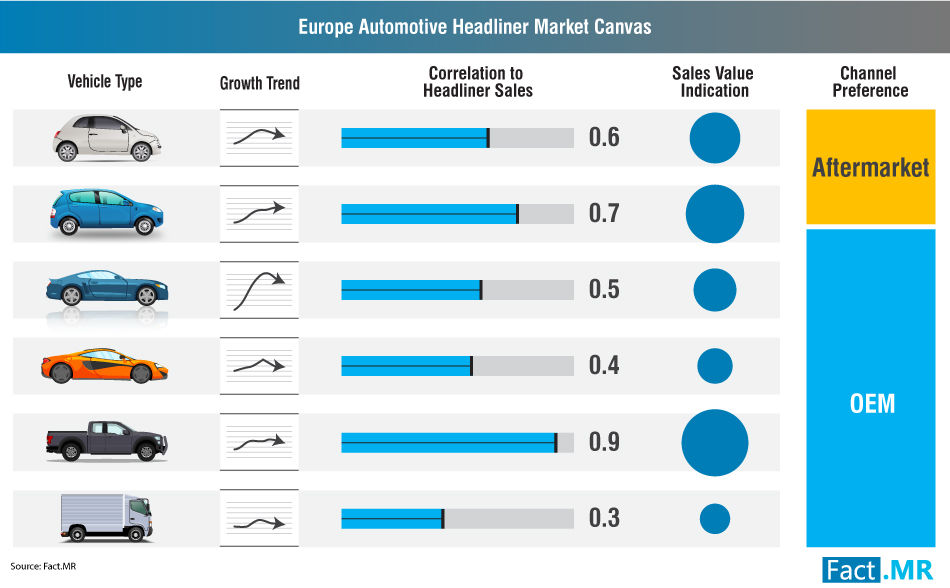DUBLIN 2, Ireland, 16-Oct-2018 — /EPR INDUSTRIAL NEWS/ — The broader disruption in the automotive sector is rubbing off on the Europe automotive headliners market, as vehicle interior air quality (VIAQ) adds to the litany of factors that influence buyer behavior. The growing consumer emphasis on interior air quality isn’t lost on component suppliers and OEMs. Incorporation of low-VOC materials and modular designs is gaining ground in the US$ 6.5 million Europe automotive headliners market, according to Fact.MR’s new study.
The Fact.MR study maintains an optimistic long-term outlook on the automotive headliners market in Europe. The study projects revenues to witness a 7.5% CAGR through 2026, with Western Europe at the forefront of sales and innovation. The lucrativeness of Europe’s automotive headliners market is likely to create a fair share of opportunities, as well as challenges for OEMs and component suppliers in the region.
Request a SampleÂ
https://www.factmr.com/connectus/sample?flag=S&rep_id=414
Europe’s preeminence in the global automotive landscape is not limited to high production and exports alone – the region leads the way for enacting stringent emission regulations and their implementation. “Automotive headliner manufacturers can expect institutions like ACEA and VDA to focus inward, leading to stringency in VIAQ regulations,†says Nandini Roy Choudhury, Senior Consultant at Fact.MR. “Considering the fact that Europe exports a sizable number of vehicles to Asia Pacific, where most of the action is taking place, European OEMs and aftermarket suppliers also need to comply with the domestic regulations, such as the Guobiao and JAMA,†adds Ms. Roy
Growing Adoption of Low-VOC Materials in Manufacturing Automotive HeadlinersÂ
According to Fact.MR’s study, a combination of global and region-specific factors will influence Europe’s automotive OEMs and aftermarket players to invest in low-VOC components. The transition of headliners from a simple covering to an integrated platform for vehicle peripherals has created the need for design innovation. The challenge to improve VIAQ has also led to experimentation with new materials, ranging from thermosets to water-based adhesives.
Know the methodology behind the report
https://www.factmr.com/connectus/sample?flag=RM&rep_id=414
“The evolving consumer demand is multipronged – it is not going to impact only a specific set of players in the supply chain, but its effects are being felt across the spectrum. Unwavering focus on cabin air quality is driving adhesive companies to innovate, bringing recyclable and biodegradable raw materials to the forefront,†adds Ms. Roy.
Germany leads the Europe automotive headliners market, accounting for over one-fourth revenue share in 2017.
Players in Germany’s automotive headliner supply chain are reliant on the broader prospects of the automotive landscape, which has been encouraging in the last couple of years.
According to Germany’s Federal Motor Authority (KBA), Germany’s new car sales reached 3.44 million in 2017, witnessing an increase of 2.7% over the previous year. German headliner and adhesive manufacturers were also supported by positive momentum in Asia Pacific, where new car sales have created significant opportunities. “Germany is not only the leading production and sales market in Europe, but also a key exporter of cars and LCVs. We can expect Germany to take the lead in this new era of flexible, sustainable, and cost-effective headliners and other interior components,†opines Ms. Roy.
The European automotive headliner market may well be dominated by Germany, but France and UKclosely follow suit. The strength of the triumvirate can be gauged from the fact that these three markets collectively held a revenue share of over 65% in 2017. Automotive headliner sales in these three top markets are driven by encouraging sales in compact and mid-sized cars.
The design innovation and incorporation of new materials in headliners and interior parts manufacturing is likely to remain concentrated in the OEM landscape. “Aftermarket sales account for less than 30% share of the European automotive headliner market, so the onus is on OEMs to take the lead,†concludes Ms. Roy.
The report is available for direct purchase at Â
https://www.factmr.com/checkout/414/S
SOURCE: EuropaWire

